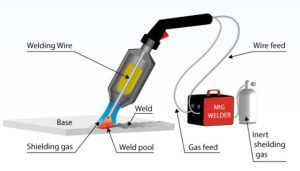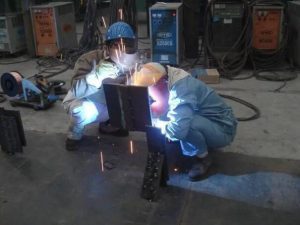There are two kinds of welding used in sheet metal fabrication projects: MIG and TIG welding. As a sheet metal fabrication vendor, choosing the correct welding method for your project can significantly impact its success. However, with many factors to consider, such as the material, thickness, and application, it can take time to decide which welding to use.
In this article, we’ll take a closer look at MIG and TIG welding and discuss their advantages and disadvantages and the applications where each method excels. By the end of this post, you’ll better understand which welding method is correct for your next sheet metal fabrication project.
Overview For MIG Welding
What is MIG welding?
MIG welding ( Gas Metal Arc Welding ) is a welding method that uses a continuous wire feed electrode and a shielding gas to create a strong bond between the base metal and the filler metal. MIG welding is fast, efficient, and easy to learn, making it a popular choice for sheet metal fabrication projects.
How it works?
MIG welding uses a special welding gun that feeds a wire electrode continuously while an electric arc melts the wire and the metal being welded. The melted metal then cools and solidifies to form a strong bond. A gas shield is used to keep the welding area clean and protected from air. This process creates a smooth and efficient weld that is great for sheet metal fabrication projects.
Advantages of MIG welding
Speed: MIG welding is a fast welding method that allows for high production rates, making it ideal for large-scale sheet metal fabrication projects.
Ease of Use: MIG welding is relatively easy to learn, and with the proper training, even beginners can achieve high-quality welds.
Versatility: MIG welding can be used on many materials, such as aluminum, stainless steel, mild steel and brass. Less Cleanup Required: MIG welding produces less slag and spatter compared to other welding methods, resulting in less post-weld Cleanup required.
Disadvantages of MIG Welding
Less Precise: MIG welding is less precise than TIG welding, making it less suitable for intricate or delicate sheet metal fabrication projects.
Not Suitable for Thinner Materials: MIG welding may not be suitable for thinner materials, as it can cause warping or burn-through due to its high heat input.
Application of MIG Welding
MIG welding is a versatile welding process that can be applied for many applications, making it a popular choice for many industries.
Automotive industry: MIG welding is commonly used in the automotive industry for welding sheet metal components such as body panels, frames, and exhaust systems.
Construction: such as metal buildings, and bridges.
Manufacturing: MIG welding is used in the manufacturing industry for welding various metal components, including machinery, equipment, and tools.
Aerospace industry: MIG welding is used in the aerospace industry for welding aircraft parts and components, including wings, fuselage, and landing gear.
Repair and maintenance: MIG welding is used to repair and maintain metal structures, equipment, and machinery in various industries.





